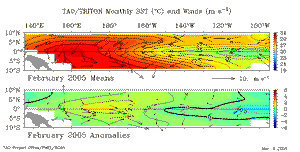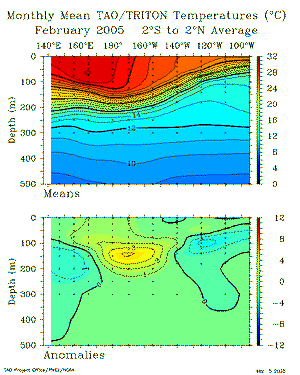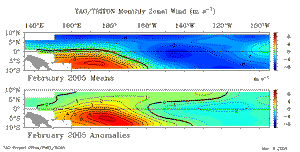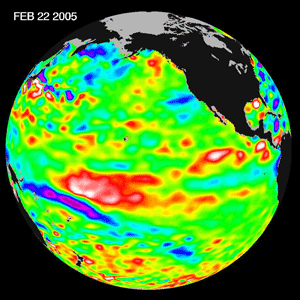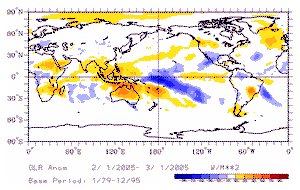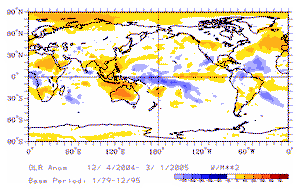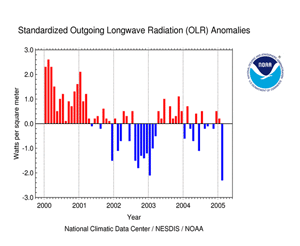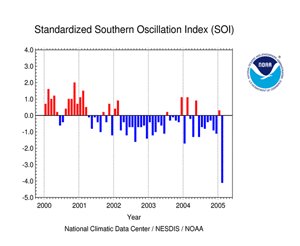SST ANOMALIES DECREASED IN THE EQUATORIAL
PACIFIC:
SOI REACHES LOWEST VALUE SINCE FEBRUARY 1983
SOI REACHES LOWEST VALUE SINCE FEBRUARY 1983
|
|
Sea-Surface
Temperatures (SSTs) and
Mixed-Layer Conditions: SSTs decreased across the entire equatorial Pacific Ocean in February, although the monthly values remained above average in the western and central parts of the basin. In the mixed-layer, above average temperatures persisted in the central equatorial Pacific, with the largest anomalies reaching over 4°C at 100-200 m depth between 170°E and 150°W. The depth of the 20°C isotherm decreased in February, with the largest anomalies developing along the equatorial cold-tongue in the eastern Pacific. For the month, the SST anomaly in the Niño 3.4 Index region in the central equatorial Pacific Ocean decreased to +0.13°C (+0.23°F) above the mean. The February monthly mean was significantly cooler than in January, when the SST anomaly was +0.68°C (+1.22°F). In the western Pacific region, the SST anomaly decreased as well in February, with a monthly averaged value of the Niño 4 Index of +0.72°C (+1.66°F) (map of Niño regions). For the most recent ocean surface temperature conditions, please see the loop of satellite-derived weekly SST anomalies for February 2005. Above average SST anomalies persisted throughout the latter-half of 2004 and into early 2005 in the western and central equatorial Pacific basin, and this can be seen in the data from NCDC's Extended Reconstructed Sea Surface Temperature dataset (ERSST version 2). Despite the significant decreases in the monthly averaged SSTs, the 3-month running mean of the Niño 3.4 Index remained slightly above +0.5°C in February. (NOTE: A running 3-month mean SST anomaly above +0.5°C in the Niño 3.4 region is one indicator that an El Niño is occurring. For the official NOAA classification scheme, please see NOAA's El Niño/La Niña Index Definition and see the CPC ENSO Diagnostic Discussion for NOAA's latest official assessment of ENSO conditions.) |
|
|
Equatorial
Zonal Winds (U-Component Winds) and Sea-Level
Topography: The trade winds were above normal across much of the eastern and central equatorial Pacific basin during February. These easterly wind anomalies increased equatorial upwelling in the mixed-layer, which led to the observed decreases in the monthly averaged SST anomalies in the Niño 1+2 and 3.4 regions. In contrast to the strong trade winds in the eastern Pacific, anomalous westerly winds developed in the western equatorial Pacific during February. Periods of unusual westerly winds along the equator are typically termed a westerly-wind-burst (WWB), and they usually form in the eastern Indian Ocean and over Indonesia in association with Madden-Julian Oscillation (MJO) activity. Anomalously strong westerly winds were observed near the Dateline during the month, and these westerly winds (i.e., positive zonal winds) were evident in both the February monthly means and anomalies measured by NOAA's Tropical Atmosphere-Ocean (TAO) buoy array. Satellite altimetry of ocean surface topography from the NASA/JPL Jason-1 satellite over the Pacific basin and global oceans is shown to the left. The westerly wind activity that began in January and persisted in February along the Equator in the western Pacific generated an oceanic Kelvin wave in the mixed-layer, which subsequently propagated eastward. The most recent Pacific overpass of the Jason-1 satellite shows that a significant area of positive sea-level anomalies associated with this Kelvin wave were present in the western equatorial Pacific basin near the end of the month (see the 22 February 2005 overpass). |
|
|
Outgoing
Longwave Radiation (OLR): The map to the left shows the spatial pattern of global OLR (in W m-2) observed by satellite during February. In general, a large region of enhanced convection and negative OLR anomalies were present along the equator near the dateline in the western equatorial Pacific region. The most recent 3-month averaged OLR anomalies were negative near the Dateline, and positive in the eastern portions of the basin and the South American coast. The large region with enhanced convection along the South Pacific Convergence Zone (SPCZ) was associated with five tropical cyclones during February (2 tropical storms and 3 major cyclones: see the South Pacific / Australia region Tropical Cyclone page and the tropical cyclone summaries on the February Global Hazards pages for further details). The monthly-averaged OLR Index shifted signs to a negative value in February, with an index of -2.3 averaged across an area centered over the Dateline in the western Pacific between 160° E and 160° W. The recent shifts in sign of the OLR Index reflected the lack of persistence of El Niño conditions in the atmosphere since it developed in mid-2004. Despite the monthly fluctuations, the February negative OLR index was the lowest since a value of -2.6 in December 1994. Therefore, this unusually low OLR index during February, and the associated convection along the Equator, have been the most significant response of the atmosphere to this point during the 2004-2005 El Niño event. Note that high frequency variability in OLR is typically associated with the Madden-Julian Oscillation (MJO) (MJO related convective activity propagates west to east in the near-equatorial region from the Indian Ocean into the Pacific Ocean approximately every 30-60 days). The latest MJO activity can be seen in CPC's graphs of Daily MJO Indices. |
| Southern
Oscillation Index (SOI): The standardized SOI switched signs from a slightly positive value in January to a strongly negative index in February, with an averaged SOI value of -4.1 for the month (note that negative SOI values are consistent with El Niño conditions). The SOI has shown some unusual behavior during the 2004-2005 El Niño. For example, during the latter-half of 2004 the weekly SOI fluctuated several times between a near-neutral value and a more negative index associated with warm event conditions (although 2004 ended with seven consecutive negative monthly values). However, the dramatic decrease in the SOI in February 2005 was almost unprecendented, and the lowest monthly value since February 1983 when the SOI was -4.6 (which was the peak of the 1982-1983 El Niño). Despite the anomalously low monthly SOI in February, the SST anomalies and other indices suggested that the current warm event remained weak and confined to the western and central parts of the equatorial Pacific at the end of the month. |
Additional Links
- ENSO Monitoring
- NOAA El Niño / La Niña Index Definition
- NOAA's Pacific Marine Environmental Laboratory (PMEL):
- NOAA's Climate Prediction Center (CPC):
- NOAA's Physical Science Laboratory
- NASA/JPL Ocean Surface Topography from Space
- Australian Bureau of Meteorology (BoM) Climate Driver Update
- IRI - International Research Institute
 NOAA's National Centers for Environmental Information
NOAA's National Centers for Environmental Information
